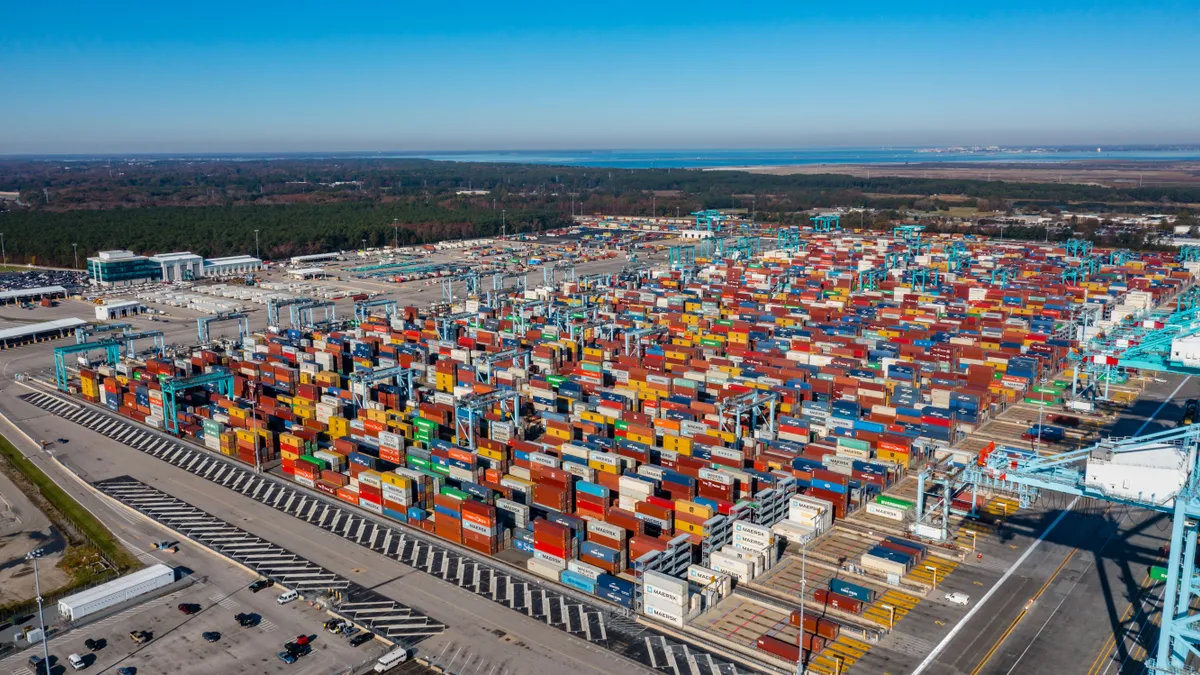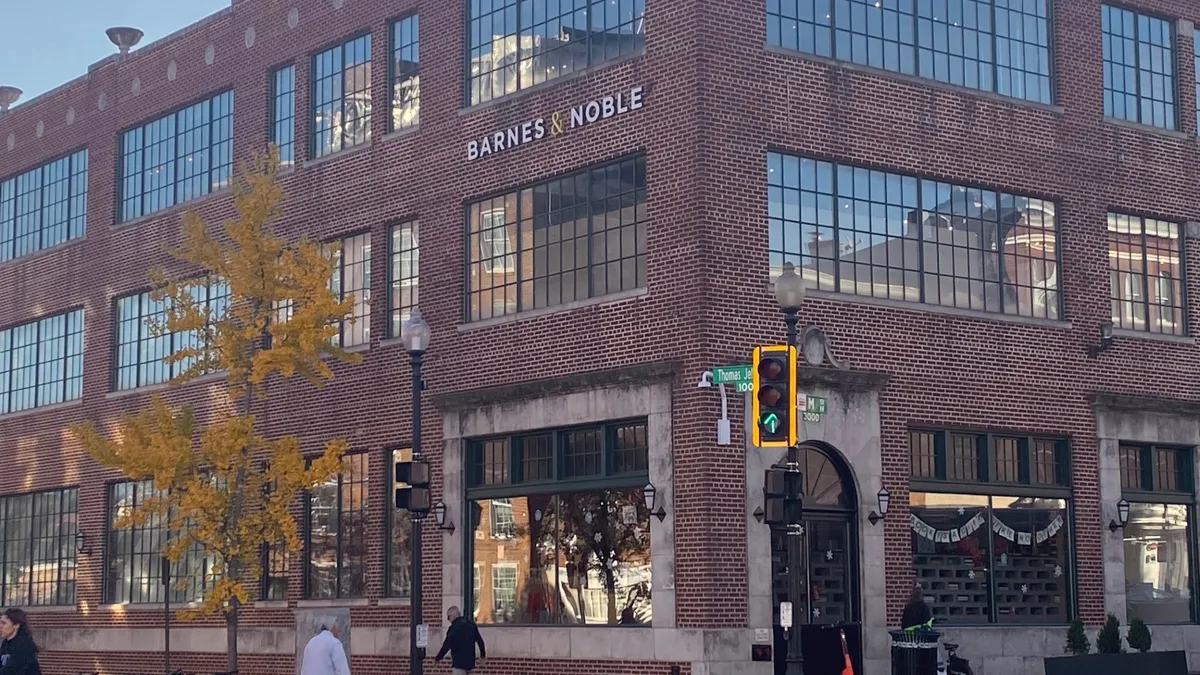If the ports are any indication of what is to come at the end of this year, trouble lies ahead for retailers this upcoming holiday season.
An August report from the National Retail Federation and Hackett Associates estimated that U.S. container ports would handle 2.37 million twenty-foot containers in August, a 12.6% bump from last year and the highest number of containers imported in one month since the NRF began tracking imports in 2002. A follow-up September report from the NRF and Hackett Associates predicts 2.21 million containers, an uptick of about 5.1% from last year. These months are important because August signifies the beginning of the peak season when retailers stock up on holiday merchandise.
Meanwhile, the COVID-19 pandemic shows no signs of slowing down. COVID-19 deaths have surpassed 684,000, and, as of Sept. 26, only 55.3% of Americans are fully vaccinated, according to the CDC.
As the coronavirus pandemic complicates the economy's recovery and ports struggle with an influx of imports, retailers are preparing for the forthcoming holiday season, which could be more complex than last year. In anticipation of the 2021 holiday season, retailers are bracing for increased shipping costs and consumers' evolving shopping habits, experts told Retail Dive. Sources said retailers are relying on automation tools and omnichannel services to meet consumer demand during the industry's busiest time of year.
Transportation troubles for deliveries and returns
Retailers continue to experience supply chain woes that began last year, such as delayed Chinese imports, the Suez Canal backlog and a labor shortage amid the surge in COVID-19 cases, said Bill Brooks, vice president of North American transportation portfolio at Capgemini, a multinational technology and consulting firm. And on the demand side, e-commerce is expected to rise, all of which could further strain the supply chain leading into the holiday season, Brooks said.
Typically, retailers begin preparing for an increase of holiday season demand in Q3, but ports have been struggling to keep up with the influx of imports, stemming from a backlog in Q1 and Q2, Brooks said.
Ports are likely "operating at full capacity now, and could be limited even further depending on what this delta variant does and what the latest surge does," Brooks said.
In response to supply chain woes, some retailers are ordering goods early to prevent in-demand items from going out of stock. Though Lowe's CFO David Denton recently noted that inventory levels are improving, the home improvement retailer still placed larger orders with its suppliers to prepare for the upcoming holiday season. Executives at Macy's and Best Buy also said they were working to bring in more inventory sooner than usual ahead of the holidays.
Meanwhile, retailers and consumers must contend with higher shipping costs. Both UPS and FedEx announced surcharges ahead of the peak shipping season. Even USPS plans to implement surcharges in October, introduce new sorting technology and lease more storage space in preparation for peak season.
Parcel providers have had to pay drivers bonuses to fulfill orders for major retailers because fulfilling those orders was no longer profitable for them, said Balika Sonthalia, partner in the strategic operations practice at Kearney, a multinational management consulting firm. Those higher shipping costs, in turn, made it more expensive to deliver goods directly to consumers' homes, Sonthalia added.
But high worker bonuses and increased shipping costs overall won't be sustainable in the long term and will soon be due for a market correction, Sonthalia said.
The State of Logistics report from Kearney and the Annual Council of Supply Chain Management Professionals noted that some retailers are considering shrinking their dedicated fleets because they want to divert some of their resources from transportation to distributed inventory. At this point, retailers' size and shifting demands could determine whether they continue investing in dedicated fleets, Sonthalia explained. For smaller retailers without their own delivery fleet, they may move away from relying on dedicated third-party fleets because it's not guaranteed that they'll have the product demand to pay for them, she said.
To combat supply shortages, some major retailers have chartered ships to bring in the inventory they need. Home Depot has chartered ships to bring inventory for its high-priority categories. Walmart made a similar move recently, too, because the company wanted to meet increased consumer demand during peak season and did not want to be hindered by a lack of capacity in the ocean shipping market.
The coronavirus pandemic also further complicated retailer's last-mile struggles. As parcel delivery companies face a "capacity crunch" and begin turning down volumes of packaging, retailers may turn to gig economy companies like DoorDash, Sonthalia said. While Instacart has teamed up with Bed Bath & Beyond, Staples and Best Buy last year, competitors like Postmates and DoorDash have added retailers like Banana Republic, PetSmart and Sam's Club.
"I'm seeing a lot of my clients, a lot of retailers are actually activating these partnerships already, just in case they have to use them in Q4," Sonthalia said. "And we may end up seeing that not because the customer said, 'Hey, I want to use DoorDash,' but because the retailer said that they actually did not have the regular parcel providers, and now they're gonna send it from the store with the last mile with the gig economy provider."
However, such partnerships aren't perfect. While traditional carriers have had years to perfect their delivery processes, gig companies' delivery networks are set up completely differently, Sonthalia said. Though gig economy companies' software and routing systems can execute deliveries, legacy parcel delivery companies have a national reach and have honed in ways to deliver goods efficiently, she said.
But it's not just last-mile fulfillment that is causing concern for retailers ahead of the upcoming holiday season; both retailers and carriers alike want to streamline the returns process.
Research suggests that both retailers and transportation and logistics companies are concerned about streamlining the returns process for consumers. According to the National Retail Federation, online returns more than doubled between 2019 and 2020. Plus, 77% of North American transportation logistics professionals said they are collaborating with retailers to streamline their returns process for shoppers, according to Soti's 2021 State of Mobility in Transportation and Logistics report.
"Every time there is a resurgence of COVID it not only impacts the consumer, but it limits the capacity of a company to serve or to produce products, and we all are seeing it in the supply chain blockages we've seen last year."

Balika Sonthalia
Partner in the Strategic Operations Practice, Kearney
Cumbersome returns processes "become the first purchase barrier," said Shash Anand, vice president of product strategy at Soti, a provider of mobile and IoT management solutions. "As an example, I may go in and purchase a couple of different extra pairs of pants or shirts or jeans, and then be able to return it if the return is easy. So a lot of companies are now looking into how you make that returns process easy."
One of the common headaches that retailers face is antiquated practices and software. Some retailers, for example, have said that their legacy technology systems aren't integrated with transportation and logistics software, leaving retailers to manually pull or copy and paste data from one software to another, Anand said. Or, some transportation and logistics companies required truck drivers to manually call in every half hour to update them on their progress, which slows them down from reaching their destination, he added.
"I want to be able to know exactly what's happening with my shipment, the entire process," Anand said. "Now you kind of expect that with almost all of the things that you purchase. Where are they? When will they arrive? I want to see a live update. So this integration between retail and [transportation and logistics] — it has to happen. And if it doesn't ... people will find that you're very slow.
Omnichannel options
As COVID-19 resurges in the U.S., preparing for the upcoming holiday season becomes more complex. Retailers, like other sectors, are facing labor shortages and limited inventory capacity, Sonthalia said.
"Every time there is a resurgence of COVID, it not only impacts the consumer, but it limits the capacity of a company to serve or to produce products, and we all are seeing it in the supply chain blockages we've seen last year," Sonthalia said.
Because consumer behavior is changing in response to the evolving pandemic conditions, retailers don't have a choice but to adopt an omnichannel approach to serve consumers and adapt to changing supplier conditions, Sonthalia said.
Retailers will also lean into omnichannel options such as buy online, pickup in store or curbside pickup, Anand said. Retailers may also equip their in-store staffers and shoppers with mobile technology to help find inventory on the floor and review information about the products available, he added. Retailers like 7-Eleven, Crate and Barrel, Kmart and Sears have previously tried out this strategy to improve the in-store shopping experience or provide useful store insights for staffers.
Though retailers have increasingly used an omnichannel approach during the pandemic, Anand expects that these options are here to stay, and some retailers will even integrate technology tools to bring customers using these omnichannel options back to their stores in the future. Other retailers, however, may continue to make fast shipping their top priority, he said.
"If the perception is that you're slow, your brand gets affected as somebody that can't change in accordance with the time ... And I think that will reduce sales," Anand said.



















